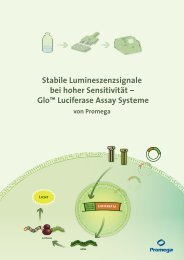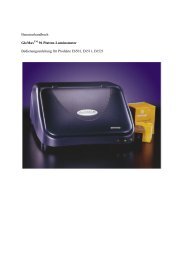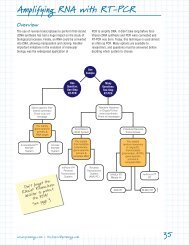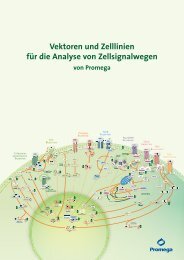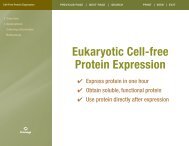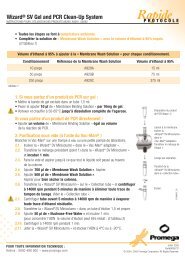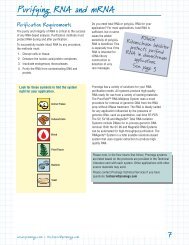The Role of Cell-Free Rabbit Reticulocyte Expression ... - Promega
The Role of Cell-Free Rabbit Reticulocyte Expression ... - Promega
The Role of Cell-Free Rabbit Reticulocyte Expression ... - Promega
You also want an ePaper? Increase the reach of your titles
YUMPU automatically turns print PDFs into web optimized ePapers that Google loves.
<strong>Cell</strong>-<strong>Free</strong> <strong>Expression</strong><br />
O‑linked Glycosylation <strong>of</strong> Cytosolic and Nuclear Proteins<br />
Secretory and membrane proteins are not the only proteins in the cell that are glycosylated.<br />
Many nuclear and cytosolic proteins are modified by O‑linked glycosylation (O‑GlcNAcylation). 25<br />
RRL contains the enzymes and substrates necessary for the O‑GlcNAcylation <strong>of</strong> proteins, 26 and<br />
addition <strong>of</strong> microsomes or SP cells provides the environment necessary for correct membrane‑<br />
protein folding. To assess whether the insulin‑responsive glucose transporter GLUT4 undergoes<br />
O‑GlcNAcylation, GLUT4 cDNA was transcribed and translated in RRL supplemented with<br />
CMMs. 25 RRL was able to successfully modify GLUT4 protein. 25<br />
Lipid Modification and Acetylation <strong>of</strong> Proteins<br />
Glycosylphosphatidyl Inositol (GPI) Anchors<br />
Some proteins are anchored to the cell membrane by means <strong>of</strong> a glycosylphosphatidyl inositol<br />
(GPI) modification at the C‑terminus. 27 Unlike proteins incorporated into the membrane by a<br />
transmembrane domain, proteins that are GPI‑anchored are reversibly associated with the lipid<br />
bilayer. GPI anchoring does not appear to be necessary for cell survival, but it is necessary for<br />
development. 28 Proteins that are modified by the addition <strong>of</strong> a GPI anchor contain two signal<br />
sequences, one at the N‑terminus that directs protein synthesis to the ER and a second at the<br />
C‑terminus that directs the addition <strong>of</strong> the GPI‑anchor by a transamidase activity. 29 Small nucleo‑<br />
philic compounds like hydrazine can substitute for GPI, providing a means to assess whether GPI<br />
modification has occurred by comparing the molecular weight <strong>of</strong> proteins translated in the presence<br />
or absence <strong>of</strong> hydrazine. 30 Human placental alkaline phosphatase (PLAP) is a GPI‑anchored pro‑<br />
tein. 24 GPI‑anchored mini‑PLAP has been generated by numerous groups using nuclease‑treated<br />
RRL supplemented with microsomal membranes from CHO, F9, EL4 or K562 cells, 24,28,29,31‑33<br />
demonstrating that GPI modification can be reconstituted in a cell‑free system.<br />
Prenylation<br />
Some proteins are modified by prenylation, the attachment <strong>of</strong> one or more isoprenoid groups,<br />
such as the 15‑carbon farnesyl group or the 20‑carbon geranylgeranyl group, to a cysteine residue.<br />
Prenylation can mediate membrane association <strong>of</strong> some proteins, particularly the Ras‑like GTPases,<br />
and protein‑protein interactions (e.g., nuclear lamins). 34 Prenylated proteins can be produced<br />
and detected in RRL supplemented with the labeled isoprenoid precursor mevalonic acid after<br />
the translation reaction is complete; additionally proteins synthesized in RRL can be modified<br />
using photoactivatable analogs <strong>of</strong> isoprenoids. 35‑37 Gel‑based assays to detect changes in protein<br />
migration as a result <strong>of</strong> prenylation are also used, but these are indirect assays and are usually<br />
performed along with a labeling experiment. Most prenylation assays require autoradiography<br />
<strong>of</strong> the labeled lysate, which can take weeks or months. Benetka and colleagues have developed<br />
an in vitro prenylation assay using N‑terminal GST‑tagged proteins and detection <strong>of</strong> 3 H‑labeled<br />
precursors using a TLC linear analyzer. 38 <strong>The</strong> incorporation <strong>of</strong> the GST tag allows the labeled<br />
protein <strong>of</strong> interest to be separated from free radioactive label and other proteins in the RRL, and<br />
using the TLC scanner to detect the incorporated lipid molecule significantly reduces the time<br />
required to obtain results.<br />
N‑Myristoylation and Palmitoylation<br />
Many proteins in eukaryotic cells are subject to N‑myristoylation, the addition <strong>of</strong> a 14‑<br />
carbon fatty acid to the N‑terminus. 39 In addition to being prenylated, the alpha subunits <strong>of</strong><br />
some G‑proteins, including pp60 src and p21 ras , are myristoylated. Other G‑protein alpha subunits,<br />
including some <strong>of</strong> the G s and G q subunits, are not myristoylated, but are instead modified by the<br />
attachment <strong>of</strong> a 16‑carbon palmitic acid (palmitoylation), and others are both myristoylated and<br />
palmitoylated. Some studies suggest that N‑myristolyation and palmitoylation contribute to the<br />
membrane association <strong>of</strong> these proteins. 40‑42 N‑myristoylation can occur cotranslationally, imme‑<br />
diately after the removal <strong>of</strong> the N‑terminal methionine from a protein or even post‑translationally<br />
as with the protein BID (BCL‑2 interacting domain), a substrate <strong>of</strong> caspase‑8. 39,43 Upon cleavage





